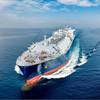The new Catamaran HSV 2 Swift was delivered to the U.S. Navy yesterday during a celebration in Hobart, Australia. High ranking US Military officers joined with invited guests to witness the handover of the 98 metre Wave Piercing Catamaran HSV 2 Swift, Incat Hull 061.
Guests were welcomed on board HSV 2 Swift by His Excellency The Honourable Sir Guy Green, AC, KBE, CVO, Governor of Tasmania.
With the Royal Australian Air Force band playing, flags flying and the usual pomp and ceremony associated with such events, the 80 or so US officers and crew were joined by representatives of the Australian Defence Force, invited guests and the entire Incat workforce.
During the ceremony Commander Clark Price, the Captain of the craft, assumed command, delivering his orders before the Hoisting of Colours, signifying that the US Navy had accepted US Navy Vessel HSV 2 Swift.
The ceremony, during which guests were seated on hay bales, was followed by an Aussie themed “barbie” complete with the ubiquitous gum trees and Hills Hoist on deck!
Speaking of this latest High Speed Vessel to hoist the Stars and Stripes, Rear Admiral Paul Ryan, Commander Mine Warfare Command, US Navy said “the name Swift is most appropriate, because of its high speed, it reached 47 knots on sea trials.”
Admiral Ryan referred to the old Navy adage that “Speed is Life”, saying that speed is a force multiplier, reducing the transit time to theatre, and therefore increasing the time on station”.
Referring to the biblical David and Goliath, Rear Admiral Ryan said “Incat is the ‘David’ of the shipbuilding industry – ten months from contract award to delivery is almost unheard of in the US……. Shipyards all over the United States would be jealously eying the technology of Swift. Local shipbuilders are wondering why they can’t do the same thing in the US.”
Robert Clifford, Chairman of the Incat Group of Companies and Executive Vice President of Bollinger/Incat USA said, “Swift is the result of the efforts of hundreds of Incat contractual and production staff and hundreds of sub-contractors. I, and fellow directors, thank the entire dedicated workforce for their outstanding efforts, through the long cold winter days and nights in the shipyard – it has all been worthwhile to be able to celebrate with the US Navy today.”
Mr Clifford went on to tell the assembled guests of plans for further Incat-built military vessels. “The US Navy is interested in many new ships, ships that will be know as Littoral Combat Ships (LCS). Swift is not a Littoral Combat Ship, it is however a forerunner of that class, and any candidate considered for that class must first exceed the specifications of this ship. That will be no easy task. Bollinger / Incat USA and Incat will be presenting in due course our Tasmanian designed ship of the future to the United States Navy” he said.
Mr Clifford also acknowledged the support of the State and Federal Governments with the Premier of Tasmania, Jim Bacon and the Australian Minister for Trade Mark Vaile attending the ceremony.
The Australian Minister for Trade, Mark Vaile said that the ceremony represents the epitome of the level of strength in the relationship between Australia and the United States.”
The High Speed Vessel (HSV) HSV 2 Swift will serve operationally as an interim Mine Warfare Command and Support Ship (MCS), and support transformational mine warfare modular mission payload initiatives. In support of Navy experimentation, the HSV will be used to explore concepts, capabilities and military utility associated with the advanced hull and propulsion technology integrated with advanced communications in support of the Littoral Combat Ship (LCS) program.
For the Marine Corps, the HSV will conduct a series of limited-objective experiments, exercises, demonstrations and training events that develop interoperability potential of high-speed vessels with causeways, watercraft, amphibious ships and other shipping. Experimentation data will be used to access the military utility of HSVs and future joint and naval military operations or applications.
The HSV is capable of maintaining an average speed of 35 knots or greater, loaded with 500 short tons, consisting of 350 personnel and military equipment. A minimum operating range of 1100 nautical miles at 35 knots is required by the contract, as is a minimum transit range of 4000 nautical miles at an average speed of 20 knots. Furthermore, she must be capable of 24-hour operations at slow speeds (3-10 knots) for experimentation with unmanned autonomous vehicles, and to support dedicated and emerging organic mine warfare missions.
A stern ramp capable of on/off loading directly astern or to the starboard quarter is fitted. The ramp is capable of loading/unloading a multitude of military vehicles up to and including M1A1 main battle tanks of up to 141,000 lbs.
Swift is also fitted with a load compensating crane capable of launch and recovery of small boats and unmanned vehicles up to 26,000 lbs. whilst underway. The crane is capable of lifting up to 22,000 lbs. to and from the flight deck.
Perhaps one of the most impressive features of Swift is the NAVAIR certified helicopter flight deck for operation of MH-60S, CH-46, UH-1 and AH-1 helicopters. An area protected from the weather for storage and maintenance of two MH-60S helicopters has also been provided to enhance aviation operations in day, night and instrument meteorological conditions.
With sea trials, Navy acceptance, and crew certification complete Swift will now deploy and commence routine operations. The vessel will operate with crews stationed at Naval Station Ingleside, Texas, and Naval Amphibious Base Little Creek, Virginia.
HSV 2 Swift is the fourth Incat Wave Piercing Catamaran to enter Military service.
In 1999 the Royal Australian Navy chartered the 86 metre Wave Piercing Catamaran HMAS Jervis Bay (Incat Hull 045) for use during the East Timor crisis. The vessel seized the attention of the worldwide military, enabling them to witness the potential of the Wave Piercing platform to perform various military roles.
In 2001, joint forces from the US Military awarded to Bollinger / Incat USA the charter for a High Speed Craft to be used as an evaluation platform for various trials and demonstrations for the different forces involved. The 96 metre Wave Piercing Catamaran HSV-X1 Joint Venture became the benchmark for future Fast Sealift acquisitions, thanks to her high operational speed, long-range deployment capabilities, combined with a high deadweight capacity.
Joint Venture has excelled during her deployment in the Persian Gulf is support of Operation Iraqi Freedom. Just hours after Operation Iraqi Freedom began, Joint Venture sped into the shallow Persian Gulf waters near the southern Iraqi port of Umm Qasr, acting as an afloat forward staging base for Marine Fleet Anti-Terrorism Security Teams and Navy SEAL commandos.
On 14 November 2002, the US Army took acceptance of its first Theater Support Vessel TSV-1X Spearhead. The craft is part of the Advanced Concept Technology Demonstrator (ACTD) program, a joint effort by the acquisition and operational (war fighter) communities within the Department of Defence (DoD). Typically ACTD’s begin by identifying significant military needs and then matching them with current commercial technology or other programs ready to focus on military application.
Sponsored Content
Experience Custom Yacht Signs and Designs Tailored to Perfection!

April 2025
 Read the Magazine
Read the Magazine

 Read the Magazine
Read the Magazine
This issue sponsored by:

Looking Back: U.S. Maritime Industry Steps Up in Wake of FSK Bridge Collapse
Subscribe for
Maritime Reporter E-News
Maritime Reporter E-News is the maritime industry's largest circulation and most authoritative ENews Service, delivered to your Email five times per week








